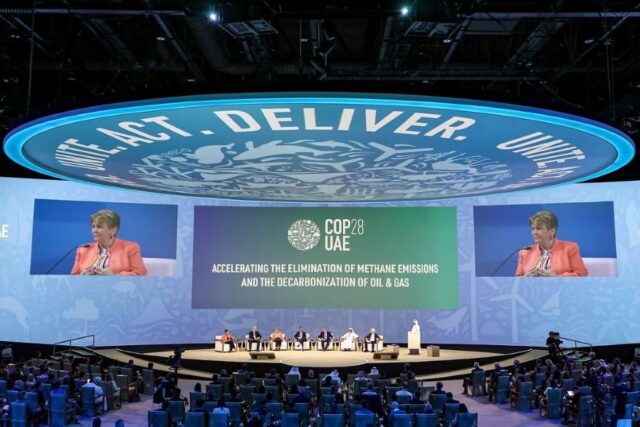…Cooling sector greenhouse gas emissions predicted to more than double by 2050
…Key measures could slow power growth, cut predicted emissions by 60-96 per cent
…End-users could save US$1 trillion annually and power sector up to US$5 trillion
…5 billion people set to benefit from access to life-saving cooling
TUE, DEC 05 2023-theGBJournal|Taking key measures to reduce the power consumption of cooling equipment would cut at least 60 per cent off predicted 2050 sectoral emissions, provide universal access to life-saving cooling, take the pressure off energy grids and save trillions of dollars by 2050, according to a new report published during the COP28 climate talks in Dubai.
The Global Cooling Watch report, Keeping it Chill: How to meet cooling demands while cutting emissions – by the UN Environment Programme-led Cool Coalition – lays out sustainable cooling measures in three areas: passive cooling, higher-energy efficiency standards, and a faster phase down of climate-warming refrigerants. Following the measures outlined in these areas would deliver the 60 per cent cuts; adding rapid power grid decarbonization would reduce sectoral emissions by 96 per cent.
The report is released in support of the Global Cooling Pledge, a joint initiative between the United Arab Emirates as host of COP28 and the Cool Coalition. Today, over 60 countries signed up to the Pledge with commitments to reduce the climate impact of the cooling sector.
“As temperatures rise, it is critical that we work together to improve energy efficiency and reduce emissions from the cooling sector while increasing access to sustainable cooling. This access is especially important for the most vulnerable communities, who have often contributed the least to climate change but are the most exposed to its impacts,” said Dr. Sultan Al Jaber, COP28 President.
“The cooling sector must grow to protect everyone from rising temperatures, maintain food quality and safety, keep vaccines stable and economies productive,” said Inger Andersen, Executive Director of UNEP. “But this growth must not come at the cost of the energy transition and more intense climate impacts. Countries and the cooling sector must act now to ensure low-carbon cooling growth. Fortunately, the solutions are available today. Getting energy efficient, sustainable cooling right offers an opportunity to cut global warming, improve the lives of hundreds of millions of people, and realize huge financial savings.”
Rapid and unsustainable growth in cooling
Climate change, population and income growth, and urbanization are increasing cooling demand, which is necessary to meet the Sustainable Development Goals. Around 1.2 billion people in Africa and Asia lack access to cooling services, putting lives at risk from extreme heat, reducing farmers’ incomes, driving food loss and waste, and hindering universal vaccine access.
“As temperatures rise, it is critical that we work together to improve energy efficiency and reduce emissions from the cooling sector while increasing access to sustainable cooling. This access is especially important for the most vulnerable communities, who have often contributed the least to climate change but are the most exposed to its impacts.”
On current growth trends, cooling equipment represents 20 per cent of total electricity consumption today – and is expected to more than double by 2050. Greenhouse gas emissions from power consumption will increase, alongside leakage of refrigerant gases, most of which have a much higher global warming potential than carbon dioxide. Under a business-as-usual scenario, emissions from cooling are predicted to account for more than 10 per cent of global emissions in 2050.
Rising demand for often inefficient equipment, including air-conditioners and refrigerators, will require large investments in electricity generation and distribution infrastructure. Inefficient equipment will also result in high electricity bills for end users, particularly in Africa and South Asia, where the fastest growth is predicted.
“The private sector has a huge role to play in financing and driving innovation to advance sustainable cooling, which can help fulfill vital local development needs and support global carbon reduction targets. We are pleased to contribute to the Global Cooling Stocktake Report and to support the Global Cooling Pledge,” said Makhtar Diop, Managing Director, International Finance Corporation.
Benefits for climate, human health, and prosperity
Following the report’s recommendations could reduce the projected 2050 emissions from business-as-usual cooling by around 3.8 billion tons of CO2e.
This would:
Allow an additional 3.5 billion people to benefit from refrigerators, air conditioners or passive cooling by 2050.
Reduce electricity bills for end users by US$1 trillion in 2050, and by US$17 trillion cumulatively between 2022—2050.
Reduce peak power requirements by between 1.5 and 2 terawatts (TW) – almost double the EU’s total generation capacity today.
Avoid power generation investments in the order of US$4 to US$5 trillion.
Adding in rapid grid decarbonization would bring the total emission cuts up to 96 per cent. G20 countries represent 73 per cent of the 2050 emission reduction potential.
The report outlines key actions to take in passive cooling strategies, higher energy efficiency standards and a faster phase down of climate-warming hydrofluorocarbon (HFC) refrigerants through the Kigali Amendment to the Montreal Protocol.
As of 2022, while more than 80 per cent of countries had at least one regulatory instrument in place in these areas, implementation remains inadequate, and an integrated approach is missing. Only 30 per cent of countries have regulations that enable action on all the three fronts.
Passive cooling measures
Passive cooling measures – such as insulation, natural shading, ventilation and reflective surfaces – can dramatically reduce cooling loads. These can be provided, in part, by the development and enforcement of building energy codes that incorporate passive cooling, and urban design.
Such strategies can curb the growth in demand for cooling capacity in 2050 by 24 per cent, result in capital cost savings in avoided new cooling equipment of up to US$3 trillion, and reduce emissions by 1.3 billion tons of CO2e.
Higher efficiency standards
Higher efficiency standards and better labelling of all cooling equipment would triple the global average efficiency of cooling equipment in 2050 from today’s levels, delivering 30 per cent of modelled energy savings, lowering energy bills and improving the resilience and financial viability of cold chains.
Critical implementing policies include regularly updated Minimum Energy Performance Standards (MEPS), financial instruments to encourage demand for higher efficiency products and regulations to avoid the dumping of low efficiency cooling equipment into developing countries.
Kigali Amendment
The world has committed to phasing down HFCs through the Kigali Amendment to the Montreal Protocol – a global deal designed to protect the ozone layer and slow climate change.
Faster action is possible and can achieve a halving of HFC emissions in 2050 – compared to the Kigali phase-down timetable – through rapid uptake of better technologies in new equipment, better refrigerant management, and stronger national enforcement.
Finance is critical
The total life-cycle cost savings of $22 trillion ($17 trillion in power costs savings and $5 trillion in power generation investments) will make the sustainable cooling transition affordable. Existing business models need to be scaled to use these savings to reduce upfront costs and make the transition affordable for all.
Financial tools include on-bill financing (when a utility pays for an upgrade and recovers the cost through monthly power bills), risk-sharing facilities, public and private investments, green mortgages, seed financing for cold chains. For many developing countries, dedicated concessional finance will be needed as well as incorporating sustainable cooling criteria into banks’ lending practices.
X-@theGBJournal|Facebook-the Government and Business Journal|email:gbj@govbusinessjournal.com| govandbusinessj@gmail.com










